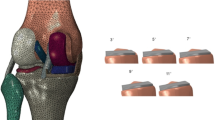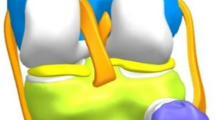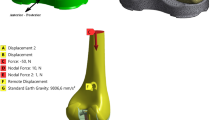Abstract
Purpose
Posterior tibial slope that is created during proximal tibial resection in total knee arthroplasty has emerged as an important factor in the mechanics of the knee joint and the surgical outcome. But the ideal degree of posterior tibial slope for recovery of the knee joint function and preventions of complications remains controversial and should vary in different racial groups. The objective of this paper is to investigate the effects of posterior tibial slope on contact stresses in the tibial polyethylene component of total knee prostheses.
Methods
Three-dimensional finite element analysis was used to calculate contact stresses in tibial polyethylene component of total knee prostheses subjected to a compressive load. The 3D finite element model of total knee prosthesis was constructed from the images produced by 3D scanning technology. Stresses in tibial polyethylene component were calculated with four different posterior tibial slopes (0°, 3°, 6° and 9°).
Results
The 3D finite element model of total knee prosthesis we presented was well validated. We found that the stress distribution in the polythene as evaluated by the distributions of the von Mises stress, the maximum principle stress, the minimum principle stress and the Cpress were more uniform with 3° and 6° posterior tibial slopes than with 0° and 9° posterior tibial slopes. Moreover, the peaks of the above stresses and trends of changes with increasing degree of knee flexion were more ideal with 3° and 6° posterior slopes.
Conclusions
The results suggested that the tibial component inclination might be favourable to 7°–10° so far as the stress distribution is concerned. The range of the tibial component inclination also can decrease the wear of polyethylene. Chinese posterior tibial slope is bigger than in the West, and the current domestic use of prostheses is imported from the West, so their demands to tilt back bone cutting can lead to shorten the service life of prostheses; this experiment result is of important clinical significance, guiding orthopaedic surgeon after the best angle to cut bone.






Similar content being viewed by others
References
Bloebaum RD, Zou L, Bachus KN, Shea KG, Hofmann AA, Dunn HK (1997) Analysis of particles in acetabular components from patients with osteolysis. Clin Orthop Relat Res 338:109–118
Peters PC, Engh GA, Dwyer KA, Vinh TN (1992) Osteolysis after total knee arthroplasty without cement. J Bone Joint Surg Am 74(7):864–876
Brach del Prever EM, Bistolfi A, Bracco P, Costa L (2009) UHMWPE for arthroplasty: past or future? J Orthopaed Traumatol 10:1–8
McKellop HA, Shen FW, Lu B (1999) Development of an extremely wear-resistant ultra-high molecular weight polyethylene for total hip replacements. J Orthop Res 17:157–167
Muratoglu OK, Bragdon CR, Jasty M (1995) The effect of radiation damage on the wear rate of UHMWPE components. In: Symposium on characterization and properties of ultra-high molecular weight polyethylene, ASTM conference
Akagi M, Asano T, Clarke IC, Niiyama N, Kyomoto N, Nakamura T (2006) Wear and toughness of crosslinked polyethylene for total knee replacements: a study using a simulator and small-punch testing. J Orthop Res 24:2021–2027
Blunn GW, Walker PS, Joshi A, Hardinge K (1991) The dominance of cyclic sliding in producing wear in total knee replacements. Clin Orthop Relat Res 273:253–260
Lee HY, Kim SJ, Kang KT, Kim SH, Park KK (2012) The effect of tibial posterior slope on contact force and ligaments stresses in posterior-stabilized total knee arthroplasty-explicit finite element analysis. Knee Surg Relat Res 24(2):91–98
Panni AS, Cerciello S, Vasso M, Tartarone M (2009) Stiffness in total knee arthroplasty. J Orthop Traumatol 10(3):111–118
Matsuda S, Miura H, Nagamine R, Urabe K, Ikenoue T, Okazaki K, Iwamoto Y (1999) Posterior tibial slope in the normal and varus knee. Am J Knee Surg 12(3):165–168
Bai B, Baez J, Testa N, Kummer FJ (2000) Effect of posterior cut angle on tibial component loading. J Arthroplasty 15(7):916–920
King AI (1984) A review of biomechanical models. J Biomech Eng 106(2):97–104
Baltzopoulos V (1995) Muscular and tibiofemoral joint forces during isokinetic concentric knee extension. Clin Biomech (Bristol, Avon) 10(4):208–214
Godest AC, Beaugonin M, Haug E, Taylor M, Gregson PJ (2002) Simulation of a knee joint replacement during a gait cycle using explicit finite element analysis. J Biomech 35(2):267–275
Kellis E (2001) Tibiofemoral joint forces during maximal isokinetic eccentric and concentric efforts of the knee flexors. Clin Biomech (Bristol, Avon) 16(3):229–236
Piazza SJ, Delp SL (2001) Three-dimensional dynamic simulation of total knee replacement motion during a step-up task. J Biomech Eng 123(6):599–606
Taylor M, Barrett DS (2003) Explicit finite element simulation of eccentric loading in total knee replacement. Clin Orthop Relat Res 414:162–171
Zheng N, Fleisig GS, Escamilla RF, Barrentine SW (1998) An analytical model of the knee for estimation of internal forces during exercise. J Biomech 31(10):963–967
Godest AC, de Cloke CS, Taylor M, Gregson PJ, Keane AJ, Sathasivan S, Walker PS (2000) A computational model for the prediction of total knee replacement kinematics in the sagittal plane. J Biomech 33(4):435–442
Liau JJ, Cheng CK, Huang CH, Lo WH (2002) The effect of malalignment on stresses in polyethylene component of total knee prostheses—a finite element analysis. Clin Biomech (Bristol, Avon) 17(2):140–146
Rawlinson JJ, Bartel DL (2002) Flat medial-lateral conformity in total knee replacements does not minimize contact stresses. J Biomech 35(1):27–34
Sathasivam S, Walker PS (1997) A computer model with surface friction for the prediction of total knee kinematics. J Biomech 30(2):177–184
Villa T, Migliavacca F, Gastaldi D, Colombo M, Pietrabissa R (2004) Contact stresses and fatigue life in a knee prosthesis: comparison between in vitro measurements and computational simulations. J Biomech 37(1):45–53
Yang RS, Lin HJ (2001) Contact stress on polyethylene components of a new rotating hinge with a spherical contact surface. Clin Biomech (Bristol, Avon) 16(6):540–546
Fernandes PR, Folgado J, Jacobs C, Pellegrini V (2002) A contact model with ingrowth control for bone remodeling around cementless stems. J Biomech 35(2):167–176
Van Rietbergen B, Huiskes R, Weinans H, Sumner DR, Turner TM, Galante JO (1993) ESB Research Award 1992. The mechanism of bone remodeling and resorption around press-fitted THA stems. J Biomech 26(4–5):369–382
Jia X, Zhang M, Li X, Lee WC (2005) A quasi-dynamic nonlinear finite element model to investigate prosthetic interface stresses during walking for trans-tibial amputees. Clin Biomech (Bristol, Avon) 20(6):630–635
Lee WC, Zhang M, Jia X, Cheung JT (2004) Finite element modeling of the contact interface between trans-tibial residual limb and prosthetic socket. Med Eng Phys 26(8):655–662
Nyman JS, Hazelwood SJ, Rodrigo JJ, Martin RB, Yeh OC (2004) Long stemmed total knee arthroplasty with interlocking screws: a computational bone adaptation study. J Orthop Res 22(1):51–57
Genin P, Weill G, Julliard R (1993) The tibial slope. Proposal for a measurement method. J Radiol 74(1):27–33
Seo SS, Kim CW, Kim JH, Min YK (2013) Clinical results associated with changes of posterior tibial slope in total knee arthroplasty. Knee Surg Relat Res 25(1):25–29
Brazier J, Migaud H, Gougeon F, Cotten A, Fontaine C, Duquennoy A (1996) Evaluation of methods for radiographic measurement of the tibial slope. A study of 83 healthy knees. Rev Chir Orthop Reparatrice Appar Mot 82(3):195–200
Soyer J, Iborra JP, Pries P, Clarac JP (2001) Mid-term behavior of the bone fixation in non-cemented Miller-Galante 1 total knee arthroplasty. Rev Chir Orthop Reparatrice Appar Mot 87(1):40–49
Wang ZW, Liu YL, Lin KJ, Qu TB, Dong X, Cheng CK, Hai Y (2012) The effects of implantation of tibio-femoral components in hyperextension on kinematics of TKA. Knee Surg Sports Traumatol Arthrosc 20(10):2032–2038
Acknowledgments
The authors are honoured to acknowledge the financial support of the Shanghai Natural Science Foundation (09410706100). The authors would like to thank Dr. Weiping Ren for his technical support in the experiments.
Conflict of interest
No conflict of interest relevant to this article was reported.
Author information
Authors and Affiliations
Corresponding author
Electronic supplementary material
Below is the link to the electronic supplementary material.
Rights and permissions
About this article
Cite this article
Shen, Y., Li, X., Fu, X. et al. A 3D finite element model to investigate prosthetic interface stresses of different posterior tibial slope. Knee Surg Sports Traumatol Arthrosc 23, 3330–3336 (2015). https://doi.org/10.1007/s00167-014-3144-9
Received:
Accepted:
Published:
Issue Date:
DOI: https://doi.org/10.1007/s00167-014-3144-9




